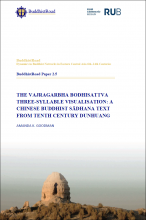BuddhistRoad Paper 2.5 "The Vajragarbha Bodhisattva Three-Syllable Visualisation: A Chinese Buddhist Sādhana Text from Tenth Century Dunhuang"
Synopsis
This paper presents a translation and study of an unidentified Chinese Buddhist visualisation text based on the four known copies recovered from the Mogao Caves (Chin. Mogao ku 莫高窟) near Dunhuang (敦煌) in Eastern Central Asia. It begins with an examination of the text’s title and principal deity, Vajragarbha, and considers its immediate manuscript contexts. Next, the paper examines the language, structure, and contents of the text, and goes on to compare it to three Tibetan Mahāyoga works from the same site: one commentary on a brief Chan (禪) meditation text and two ritual commentaries on the same root sādhana. In lieu of a formal identification of the Chinese text, the paper situates all seven manuscripts, four Chinese and three Tibetan, within the wider manuscript matrix of 10th century Dunhuang, and speculates on what these textual sources can tell us about the local reception of Tantric Buddhism in the Dunhuang region during the late Guiyijun (851–1036?, 歸義軍, Return-to-Allegiance Army) period.
Chinese Translation
本文根据中亚东部敦煌附近的莫高窟中已发现的四个文本, 翻译并研究了一篇未被勘定的汉传佛教观修文本. 本文首先研究了该文本的标题和主尊金刚藏, 并考察了其直观的写本背景. 随后对该文本的语言, 结构和内容进行了考察, 并将其与同一地点的三个藏传摩诃瑜伽文本——一个简短的禅修文本注疏和两个对同一成就法仪轨的注疏——进行了比较. 笔者未对汉文本进行勘定, 而是将全部七个写本 (四个汉文本和三个藏文本) 置于敦煌10世纪更广泛的写本群中, 以探究这些归义军 (851–1036?) 晚期的文本在敦煌地区密教本土化方面可以为我们提供哪些信息.

Downloads
Published
Categories
License

This work is licensed under a Creative Commons Attribution-NonCommercial-NoDerivatives 4.0 International License.

